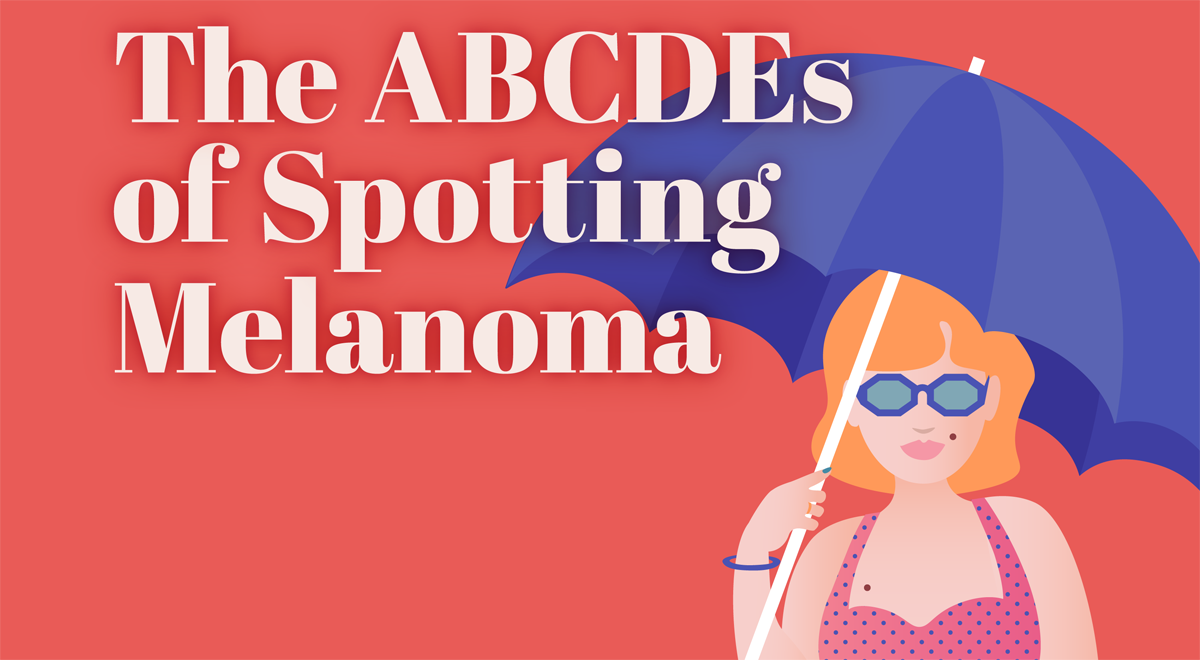Medically reviewed by Elizabeth Liotta, M.D.
Infographic text
1 in 40 women will be affected by melanoma, the most serious type of skin cancer, in her lifetime.
What is melanoma?
Melanoma is a type of skin cancer that can develop anywhere on your body.
In white people, melanoma is most common on the face, arms, leg and back.
In people of color, melanoma is most common on the palms of the hand, the soles of the feet and fingernail and toenail beds.
What does melanoma look like?
It can be hard to see signs of skin cancer if you don’t know what you’re looking for. One simple trick to help you spot melanoma? Remember your ABCDEs.
The ABCDE Assessment: 5 Warning Signs of Melanoma
Asymmetry
One side of the mole is different from the other
Border
Mole has an irregular border (edge) that is not well-defined
Color
Colors (or shades of color) vary from one area of the mole to the next
Diameter/ Dark
Mole measures 1/4 inch or larger (about the size of a pencil eraser) or is darker than other moles
Evolving
The mole is changing in shape, size or color
There’s a map for that!
The American Academy of Dermatology has a downloadable body mole map where you can make notes during your self-exams.
Beware the ugly duckling
The “ugly duckling” is a mole that looks different from all the others, and it’s another warning sign of melanoma.
Screening saves lives!
Another tool to put in your skin cancer detection toolbox? Yearly screenings, which are especially important if you’re at increased risk for skin cancer.
Some risk factors :
- Fair hair or skin
- Freckles
- Blue or light-colored eyes
- More than 50 moles
- History of frequent or intense sun exposure
- One or more blistering sunburns
- Family history of melanoma
Melanoma is highly treatable when it’s caught early. Knowing the warning signs of melanoma and regularly checking your skin can help you spot skin cancer early, before it has a chance to spread.
- The average 5-year survival rate for melanomas that are caught early is about 99%
- Once melanomas spread to the lymph nodes, the 5-year survival rate drops to 62%
- If melanomas spread to farther body sites, such as organs, that number drops to 18%
Treating melanoma
How melanoma is treated depends on how deep it is and if it has spread.
- Most melanomas are removed with minor surgery that cuts out the cancer and some of the normal skin surrounding it.
- More advanced melanomas may call for more invasive surgery and/or other treatments, such as radiation therapy.
When in doubt, check it out!
If you have a mole that looks like it might be a problem but you’re not sure, talk to a healthcare provider.
Melanoma Resource List
HealthyWomen Resources
- My Melanoma Was Dismissed as an Inflamed Hair Follicle
- Why Are People of Color More Likely to Die from Skin Cancer?
- Melanoma 101 — Risk Factors, Diagnosis, Stages and Treatment
- I Was Wrong to Think Ethnicity Made Me Immune to Skin Cancer
- What Is Melanoma? A Reel by Dr. Obioha
En Español
- El ABCDE para identificar melanomas
- Melanoma 101 — Risk Factors, Diagnosis, Stages and Treatment
- Estaba equivocada al pensar que la etnia me hizo inmune al cáncer de piel
- ¿Por qué las personas de color tienen más probabilidades de morir de cáncer de piel?
Additional Resources
- Melanoma – Symptoms and causes
- Melanoma Skin Cancer | Understanding Melanoma
- Racial Disparities in Skin Cancer Diagnosis, Prognosis, and Treatment – Oncology Nurse Advisor
- How to prevent skin cancer (aad.org)
- Black Derm Directory | BDD | Skin of Color Dermatology
This resource was created with support from Merck.
















